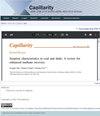纤维膨胀对棉织物中流体流动影响的实验研究
Q1 Physics and Astronomy
引用次数: 0
摘要
卫生巾、纸尿裤等卫生用品的设计很大程度上依赖于织物的吸液性能。纤维在吸液时膨胀,其吸液性能发生变化。了解在膨胀条件下通过多孔介质的流动对产品设计具有重要意义,但尚未得到充分阐明。我们的研究目的是通过实验研究纤维膨胀的影响。选择棉花作为测试织物,因为它通常用于大多数卫生应用。在膨胀条件下,分析了膨胀对棉织物的单个纤维、孔隙率、透气性和性能的影响。结果表明,在完全膨胀条件下,吸水后纤维直径增加10%,孔隙度降低11%,渗透率降低60%。利用从纤维膨胀测量中获得的数据,对孔隙率的降低也进行了分析预测。相比之下,常用分析模型的预测结果显示,孔隙度仅降低了30%。为了纠正这一点,提出了两个新的校正因子来解释纤维间相互作用对织物总膨胀率的影响。膨胀条件下棉质试样的性能测试表明,棉质试样的下表面流动锋的推进比上表面更占优势,这可能与重力有关。这些实验数据提高了我们对排芯流动的理解,有助于改进卫生产品的设计和开发更现实的计算流体动力学模型。本文章由计算机程序翻译,如有差异,请以英文原文为准。
The effect of fibre swelling on fluid flow in cotton fabrics: An experimental study
: Design of hygiene products such as sanitary napkins, diapers, etc. is heavily dependent on the liquid absorption performance of fabrics. As fibres swell upon liquid absorption, their liquid absorption performance changes. Understanding the flow through porous media under swelling conditions has important implications for product design and has yet to be elucidated fully. The goal of our research was to study the effect of fibre swelling experimentally. Cotton is selected as the test fabric as it is commonly used in most hygiene applications. Under swelling conditions, the effect of swelling on individual fibres, porosity, permeability, and performance of the cotton fabric is analysed. Findings showed that upon water absorption, the fibre diameter increased by 10%, porosity decreased by 11%, and permeability decreased by 60% under fully swollen conditions. The porosity reduction is also predicted analytically using the data obtained from the fibre swelling measurements. In contrast, predictions of commonly used analytical models showed only a 30% reduction in the porosity. To correct this, two new correction factors to account for effects of inter-fibre interactions on the total swelling rate of fabric are proposed. The performance measures of cotton samples under swelling conditions indicated that advancement of the flow front on the lower face was more dominant than the upper face of the sample possibly related to gravity. These experimental data improve our understanding of wicking flow which can help to improve the design of hygiene products and to develop more realistic computational fluid dynamics models.
求助全文
通过发布文献求助,成功后即可免费获取论文全文。
去求助
来源期刊

Capillarity
Physics and Astronomy-Surfaces and Interfaces
CiteScore
7.10
自引率
0.00%
发文量
15
审稿时长
2~3 weeks
期刊介绍:
Capillarity publishes high-quality original research articles and current reviews on fundamental scientific principles and innovations of capillarity in physics, chemistry, biology, environmental science and related emerging fields. All advances in theoretical, numerical and experimental approaches to capillarity in capillary tube and interface dominated structure and system area are welcome.
The following topics are within (but not limited to) the scope of capillarity:
i) Capillary-driven phenomenon in natural/artificial tubes, porous and nanoporous materials
ii) Fundamental mechanisms of capillarity aided by theory and experiments
iii) Spontaneous imbibition, adsorption, wicking and related applications of capillarity in hydrocarbon production, chemical process and biological sciences
iv) Static and dynamic interfacial processes, surfactants, wettability, film and colloids
v) New approaches and technologies on capillarity
Capillarity is a quarterly open access journal and free to read for all. The journal provides a communicate platform for researchers who are interested in all fields of capillary phenomenon.
 求助内容:
求助内容: 应助结果提醒方式:
应助结果提醒方式:


